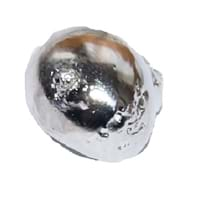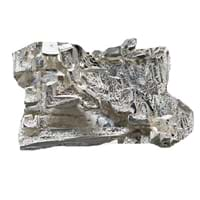Rhodium Silver Comparison
Periodic Table
Symbol
Rh
Ag
Group Number
9
9
11
7
Period Number
5
5
Block
d block
d block
Element Family
Transition Metal
Transition Metal
CAS Number
7440166
99+
7440224
99+
Space Group Name
Fm_ 3m
Fm_ 3m
Space Group Number
225.00
2
225.00
2
Facts
Interesting Facts
- Rhodium is the rarest element out of all non-radioactive metals on the earth .
- Rhodium is one of the most durable and hard metal, which also have high reflectance.
- It is the most reflective element.
- Silver is the second most ductile metal after Gold.
- It is also used in Dentistry as a dental alloys for clips and crowning.
Sources
Earth's crust, Found As a By-product, Found in Minerals, Mining
Earth's crust, Found in Minerals, Ores of metals
History
Who Discovered
William Hyde Wollaston
Unknown
Discovery
In 1804
Before 5000 BC
Abundance
Abundance In Universe
6 * 10-8 %
26
6 * 10-8 %
26
Abundance In Sun
~0.0000002 %
25
~0.0000001 %
26
Abundance In Meteorites
0.00 %
36
0.00 %
38
Abundance In Earth's Crust
0.00 %
99+
0.00 %
99+
Abundance In Oceans
Not Available
0.00 %
19
Uses
Uses & Benefits
- Rhodium metal is mainly used in catalytic converters for cars as it reduces nitrogen oxides in exhaust gases.
- It is used as an industrial catalyst for nitric acid, acetic acid, hydrogenation reaction, etc.
- Silver is mainly used for Jewelry and show piece.
- It is used for manufacturing high quality mirrors due to its reflectivity property.
Industrial Uses
Aerospace Industry, Automobile Industry, Electrical Industry, Electronic Industry
Chemical Industry, Clothing Industry, Electrical Industry
Medical Uses
NA
Dentistry, Pharmaceutical Industry
Other Uses
Alloys
Alloys, Bullion, Coinage, Jewellery, Sculptures, Statues
Biological Properties
Toxicity
NA
Non Toxic
Present in Human Body
No
Yes
In Blood
Not Available
0.00 Blood/mg dm-3
29
In Bone
Not Available
0.44 p.p.m.
20
Physical Properties
Melting Point
1,966.00 °C
12
961.93 °C
99+
Boiling Point
3,727.00 °C
17
2,212.00 °C
99+
Appearance
Physical State
Solid
Solid
Color
Silvery White
Silvery White
Luster
Metallic
Metallic
Hardness
Mohs Hardness
6.00
6
2.50
14
Brinell Hardness
980.00 MPa
9
251.00 MPa
37
Vickers Hardness
1,100.00 MPa
9
229.00 MPa
30
Speed of Sound
4,700.00 m/s
15
2,680.00 m/s
34
Optical Properties
Reflectivity
84.00 %
4
97.00 %
1
Allotropes
No
No
α Allotropes
Not Available
Not Available
β Allotropes
Not Available
Not Available
γ Allotropes
Not Available
Not Available
Chemical Properties
Chemical Formula
Rh
Ag
Isotopes
Known Isotopes
16
23
36
3
Electronegativity
Pauling Electronegativity
2.28
3
1.93
9
Sanderson Electronegativity
Not Available
1.83
11
Allred Rochow Electronegativity
1.45
16
1.42
18
Mulliken-Jaffe Electronegativity
Not Available
1.47
15
Allen Electronegativity
1.56
24
1.87
7
Electropositivity
Pauling Electropositivity
1.72
99+
2.07
99+
Ionization Energies
1st Energy Level
719.70 kJ/mol
29
731.00 kJ/mol
27
2nd Energy Level
1,740.00 kJ/mol
26
2,070.00 kJ/mol
11
3rd Energy Level
2,997.00 kJ/mol
27
3,361.00 kJ/mol
19
Electrochemical Equivalent
1.28 g/amp-hr
99+
4.02 g/amp-hr
7
Electron Work Function
4.98 eV
6
4.26 eV
20
Other Chemical Properties
Anti Corrosion, Ionization, Radioactive Isotopes
Chemical Stability, Ionization, Solubility
Atomic Properties
Atomic Number
45
99+
47
99+
Electron Configuration
[Kr] 4d8 5s1
[Kr] 4d10 5s1
Crystal Structure
Face Centered Cubic (FCC)
Face Centered Cubic (FCC)
Crystal Lattice
FCC-Crystal-Structure-of-Rhodium.jpg#100
FCC-Crystal-Structure-of-Silver.jpg#100
Atom
Number of Protons
45
99+
47
99+
Number of Neutrons
58
99+
61
99+
Number of Electrons
45
99+
47
99+
Radius of an Atom
Atomic Radius
134.00 pm
99+
144.00 pm
36
Covalent Radius
142.00 pm
99+
145.00 pm
39
Van der Waals Radius
200.00 pm
28
172.00 pm
38
Atomic Weight
102.91 amu
99+
107.87 amu
99+
Atomic Volume
8.30 cm3/mol
99+
10.30 cm3/mol
99+
Adjacent Atomic Numbers
Valence Electron Potential
64.00 (-eV)
22
11.40 (-eV)
99+
Lattice Constant
380.34 pm
27
408.53 pm
20
Lattice Angles
π/2, π/2, π/2
π/2, π/2, π/2
Lattice C/A Ratio
Not Available
Not Available
Mechanical Properties
Density
Density At Room Temperature
12.41 g/cm3
28
10.49 g/cm3
35
Density When Liquid (at m.p.)
10.70 g/cm3
14
9.32 g/cm3
21
Tensile Strength
951.00 MPa
5
Not Available
Viscosity
Not Available
Not Available
Vapor Pressure
Vapor Pressure at 1000 K
Not Available
0.00 (Pa)
14
Vapor Pressure at 2000 K
0.02 (Pa)
19
Not Available
Elasticity properties
Shear Modulus
150.00 GPa
6
30.00 GPa
23
Bulk Modulus
275.00 GPa
5
100.00 GPa
16
Young's Modulus
380.00 GPa
5
83.00 GPa
23
Poisson Ratio
0.26
22
0.37
7
Other Mechanical Properties
Malleable
Ductile, Malleable
Magnetic Properties
Magnetic Characteristics
Specific Gravity
12.41
20
10.50
26
Magnetic Ordering
Paramagnetic
Diamagnetic
Susceptibility
Not Available
0.00
5
Electrical Properties
Electrical Property
Conductor
Conductor
Resistivity
43.30 nΩ·m
99+
15.87 nΩ·m
99+
Electrical Conductivity
0.21 106/cm Ω
8
0.63 106/cm Ω
1
Electron Affinity
109.70 kJ/mol
7
125.60 kJ/mol
5
Thermal Properties
Specific Heat
0.24 J/(kg K)
22
0.24 J/(kg K)
25
Molar Heat Capacity
24.98 J/mol·K
99+
25.35 J/mol·K
99+
Thermal Conductivity
150.00 W/m·K
9
429.00 W/m·K
1
Critical Temperature
Not Available
Not Available
Thermal Expansion
8.20 µm/(m·K)
99+
18.90 µm/(m·K)
23
Enthalpy
Enthalpy of Vaporization
495.40 kJ/mol
12
255.10 kJ/mol
37
Enthalpy of Fusion
21.76 kJ/mol
10
11.30 kJ/mol
31
Enthalpy of Atomization
556.50 kJ/mol
12
284.50 kJ/mol
37
Standard Molar Entropy
31.50 J/mol.K
99+
42.60 J/mol.K
35
|
||
|
||
|












